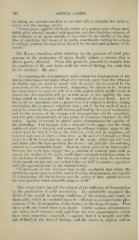Page 732 - My FlipBook
P. 732
742 DENTAL CARIES.
by taking an extreme case that we are best able to examine the mode of
action and the ensuing results.
" Litmus-paper applied within the cavity of a carious tooth almost inva-
riably gives strongly-marked acid reaction, and thus furnishes evidence of
the existence of an agent capable, if unresisted by the vitality of the den-
tine, of depriving that tissue of its earthy constituents, leaving the gelatin
to undergo gradual decomposition, favored by the heat and moisture of the
mouth."
JNIr. Tomes, tlierefore, while insistino; on the presence of vital phe-
nomena in the })roduction of caries, finally admits a process that is
almost purely chemical. From this point he proceeds to examine into
the condition of the oral fluids with the view of finding the acids that
do the mischief. He says :
" In examining the circumstances under which the decomposition of the
dentine takes place and under which it is resisted, apart from the influence
of vitality, any one must be struck with the power that is exerted by the
mere form of the surface involved. Supposing the disease to be situated
in a deep Assure or upon the side of a tooth against which another tooth is
placed, the decomposition will go on with more or less rapidity, the rate
being varied in accordance with the condition of the oral fluids. But if
the cavity be superficial, and so placed that it is subject to friction during
mastication, the progress is relatively slow ; and if the low walls of such a
cavity be removed, the part will become polished by the act of mastication
and l)y the motions of the tongue, and decomposition will be completely
arrested quite independently of any ])ower of resistance exercised by vital
action. Again, let a tooth be placed under circumstances the opposite of
the preceding. For example, take a bicuspid of the upper jaw the distal
surface of which is decayed, and remove the softened dentine ; then let dry
cotton wool be forced between the defective tooth and its neighbor, and
renewed only once in three or four days ; at the end of a fortnight or three
weeks it will be found that the surface of the cavity, which Avas left hard
and dense after the first operation, has become soft, and that the softening
extends to a considerable depth. Had the cotton, prior to its inti^oduction
between the teeth, been dii:)ped into a solution of resinous gum, such as
mastic, the surface of the cavity would have remained unaltered, owing to
the exclusion of moisture. But where .the wool only is used, the secretions
of the mouth are not only not excluded, but are held in constant apposition
with the exposed dentine by the saturated wool.
" Fxperiments of this character lead to the conclusion that Avithin the
mouth are agents present which, under favoring circumstances, are capable
of decomposing the dental tissues, and the source of these agents becomes
the next question which naturally suggests itself."
This astute writer has left the subject of the influence of fermentation
in tlie production of acids untouched. He attentively examined the
fluids of the mouth in varying conditions of the system, and found in
them acids, which he concluded must be sufficient to account for the phe-
nomena of the disintegration of the dentine in the form of caries. That
these acids are fi)und there is no doubt. Under various circumstances
the saliva itself becomes acid, and from my own examinations, which
have been somewhat extended, it api)ears that it is usually acid (the
mixed fluid) in the state of fasting ; and the mucus is slightly acid in


